How to treat respiratory diseases such as bronchitis naturally
On average, an adult person suffers from a respiratory disease two to four times a year. Children are affected even more frequently. The disease is accompanied by unpleasant symptoms such as coughing, shortness of breath and nasal discharge. Those who have good immune defences are much less likely to fall ill.
Vital mushrooms have the ability to strengthen the immune system and keep it in a stable balance. In addition, they bring relief in acute as well as chronic complaints in the respiratory tract. Learn more about the different respiratory diseases, how you can strengthen your immune defences naturally and which vital mushrooms help with which symptoms.
How do respiratory diseases develop?
Next to the digestive tract, our respiratory tract forms the largest surface of the body that is in direct contact with the environment. It is important to protect this boundary. Mucous membranes in the respiratory tract exist precisely for this purpose. Their mucus keeps antigens from entering the body and clears the respiratory tract of pathogens as well as foreign bodies. If this defence mechanism is on constant alert due to various influences, which we will explain below, there is increased mucus production. This manifests itself in a cough with often viscous sputum.
Risk factors
Pollutants in the air and environmental pollution such as fine dust, nitrogen oxides and ozone represent a major challenge for our respiratory tract. These put the mucous membranes under constant stress. Other factors such as tobacco consumption and contact with allergens challenge the immune system. Other environmental conditions make the work of the natural defence mechanisms more difficult: cold worsens the blood circulation in the respiratory tract, while dry heating air and decongestant nasal drops hinder the natural function of the mucous membranes. Once a viral infection has broken out, a bacterial infection often comes on top. The symptoms worsen and the healing process takes longer.
Anything that interferes with the work of the immune system plays into the hands of a respiratory illness. For example, cold weather, lack of exercise, stress, lack of sleep, and micronutrient deficiencies weaken the immune system. In the case of chronic diseases, genetic vulnerability and psychosomatic factors often come into play. Thus, repressed emotions as well as unexpressed thoughts may be hidden behind a chronic respiratory disease. Pathophysiologically, chronic respiratory diseases are often caused by excessive or even deficient immune reactions as well as persistent inflammations. These findings are essential if you want to heal severe respiratory diseases such as chronic bronchitis naturally.
Causes of respiratory infections
Flu-like infections, which also affect the respiratory tract, are often triggered by viruses. Basically, corresponding viruses are ubiquitous in our environment. They are transmitted from one person to another via smear infection (e.g. nasal secretions on the hands) or droplet infection (e.g. coughing, sneezing). Below is a list of possible viruses and their effects on our respiratory tract: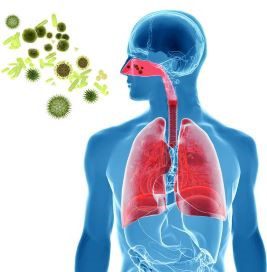
- Rhinoviruses: cold
- Parainfluenza viruses: sore throat (pharyngitis), hoarseness
- RS viruses: sore throat (tonsillitis), cough
- Corona viruses: sore throat, cough, sputum, fever (bronchitis)
- Influenza viruses: sore throat, muscle and joint pain, cough
- Adenoviruses: cough, sputum, fever (bronchitis)
A little insight into the respiratory system
For a better understanding we briefly will outline the anatomical basis of our respiratory system. There is the upper respiratory tract, which includes the nose, mouth, throat and larynx. The lower respiratory tract is made up of the trachea and the lungs. The bronchi are located in the lungs. These are increasingly smaller air passages that finally end in the alveoli, the air sacs in the lungs. This is where the gases are exchanged between blood and air.
The natural protection of the respiratory tract
The largest part of our respiratory tract is covered by the so-called respiratory epithelium. This is a natural protective layer that is supposed to protect the organism from unwanted intruders from the environment. This epithelium consists of
1. cilia: These are small protrusions in the cell membrane that look like hairs under a microscope. They are constantly in motion and strive to transport foreign bodies and mucus toward the throat out of the airways.
2. goblet cells: These cells are responsible for producing mucus, which in turn is needed to moisten the air we breathe.
3. club cells: These cells are located in the smallest bronchi and in the alveoli. They produce a secretion that is needed for the proper functioning of breathing.
But not only the respiratory tract is covered with a mucous membrane and the corresponding cells. In our body there is a total of about 500 square meters of mucous membrane surface, for example also in the intestine. Underneath all this mucous membrane sits lymphatic tissue, which is an important component of our immune system. When the mucosa comes into contact with antigens (pathogens, allergens, …), these are absorbed by the M-cells in the mucosa and passed on to the deeper-lying lymph follicles. Thereupon, the B lymphocytes produce corresponding antibodies as well as the immunoglobulins A and M (IgA, IgM). These in turn label the antigens and bind them. At the same time, further defence mechanisms are initiated to prevent further penetration of the antigens.
The importance of the intestine for the respiratory tract
The intestine and the immune system are closely related. Thus, a healthy intestinal environment is the basis for strong defences. The immunological processes in the intestinal mucosa also have an indirect effect on the defensive power of the mucous membranes in the respiratory tract: If the intestinal mucosa comes into contact with an antigen, B lymphocytes are formed at this site. These transform into lymphoblasts, which migrate via the lymph vessels running under the mucosa to the lymph nodes. From there, they enter the blood directly via the thoracic duct. Via the blood vessels, they finally reach other mucous membranes in the body as active IgA plasma cells, including those in the respiratory tract.
As a result, the production of secretory immunoglobulin A (sIg A) increases in the mucous membranes of the respiratory tract. The sIg A binds to bacteria and viruses, whereupon the ciliated epithelium transports the entire “package” out of the body. In general, sIg A, when present in sufficient quantities, forms a kind of antibiotic protective layer on mucous membranes to prevent pathogens from attaching. It is not uncommon for people with an increased susceptibility to infections to have a deficiency of this protective immunoglobulin (sIg A). In addition to the connection described above, an intact intestinal flora is associated with other advantages for the immune system. In a sense, a healthy digestive tract forms the basis for a strong immune system with balanced responses that prevent respiratory diseases such as coughing or asthma from occurring in the first place.
Which respiratory diseases exist?
Before we go into more detail about the most common respiratory diseases, we would like to give you an overview of all diseases in the respiratory tract:
Upper respiratory tract
– acute and chronic rhinitis
– acute and chronic sinusitis
– tonsillitis (angina)
– laryngitis
Lower respiratory tract
– acute and chronic bronchitis
– pneumonia
– bronchiectasis (chronic disease with cough and sputum)
– COPD (chronic obstructive pulmonary disease)
– emphysema
– bronchial asthma
– cystic fibrosis (inborn error of metabolism)
Sinusitis
About every 200th cold leads to sinusitis. Because of the cold, the sinuses are insufficiently ventilated and the mucus can only drain away from them poorly or not at all. This creates an ideal environment for inflammation. They can affect the sinuses on the side, above or behind the nose. In most cases, a viral infection is the cause of the symptoms. In unfavourable cases, a bacterial superinfection can also occur.
You can usually recognize sinusitis by facial pain 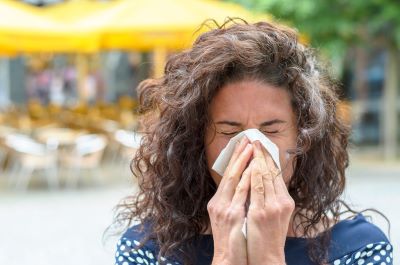 when you lean forward. For some, it also feels like they have a toothache in their upper jaw. Other symptoms include a blocked nose, purulent nasal discharge, a feeling of pressure in the sinuses and poor sense of smell.
when you lean forward. For some, it also feels like they have a toothache in their upper jaw. Other symptoms include a blocked nose, purulent nasal discharge, a feeling of pressure in the sinuses and poor sense of smell.
The following factors favour the development of a sinusitis:
– frequently recurring infections
– inflammation of the roots of the teeth
– allergies/food intolerances (they play a role in about 50% of all cases!)
– curvature of the nasal septa
– Nasal polyps
– Psychological stress
– Incorrect use of decongestant nasal sprays
Congestant nasal sprays and drops impair the mucous membrane environment in the nose and sinuses and thus also the local defence mechanisms.
What to do against sinusitis?
What measures are suitable for combating sinusitis? The following natural remedies, in addition to the use of medicinal mushrooms, have proven themselves time and again:
– Nasal rinses with saline solution
– Steam baths
– Red light
– Phytotherapy
– Intestinal cleansing (especially for recurring infections)
Bronchitis
Bronchitis is a relatively common respiratory disease. On average, there are 80 cases of acute bronchitis per week and per 100,000 inhabitants. In the winter months, this number can even double. Chronic bronchitis affects between 10 and 15% of the population.
Bronchitis is an inflammation of the mucous membrane in the bronchial tubes. This is accompanied and often preceded by an inflammation of the upper respiratory tract.  In 90% of cases, viruses are the cause. These can paralyse or even destroy the cilia, so that the bronchial mucus is only removed slowly or not at all. The body tries to clear the airways by coughing. Sputum is produced. The inflammation of the bronchial tubes is usually accompanied by fever and other typical symptoms of a cold. Natural remedies such as vital mushrooms can provide relief and improve the overall condition of those affected.
In 90% of cases, viruses are the cause. These can paralyse or even destroy the cilia, so that the bronchial mucus is only removed slowly or not at all. The body tries to clear the airways by coughing. Sputum is produced. The inflammation of the bronchial tubes is usually accompanied by fever and other typical symptoms of a cold. Natural remedies such as vital mushrooms can provide relief and improve the overall condition of those affected.
According to the WHO, we talk about a chronic bronchitis when there is sputum and coughing on the majority of days over a period of at least three months in two consecutive years. Typical of chronic bronchitis are severe coughing attacks in the morning. In addition, there is a lot of mucus of viscous consistency. Due to the continuing inflammation in the bronchial tubes, the ciliated epithelium gradually breaks down. Newly formed mucus is hardly removed. This is associated with an increased risk of more serious respiratory diseases such as COPD.
How can bronchitis be treated?
Curing acute bronchitis naturally is entirely possible. Even with chronic bronchitis, the following natural remedies can bring great relief:
– Quit smoking
– Immune therapy and anti-inflammatory therapy, e.g. with vital mushrooms
– Chest compresses
– Respiratory therapy
– Intestinal cleansing, e.g. with bitter substances
– Avoiding foods that cause mucus, e.g. milk
Asthma
Bronchial asthma is a chronic disease of the respiratory tract. Typical symptoms are whistling breathing, dry cough and so-called asthma attacks. In these attacks, a feeling of tightness builds up in the chest and breathing sometimes becomes extremely difficult for those affected. These attacks of breathlessness can last from a few minutes to several hours.
Who gets asthma?
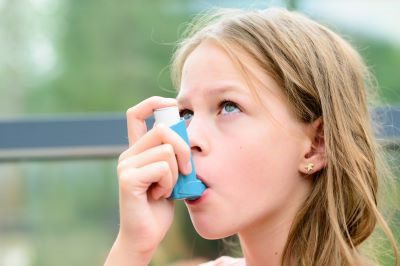 In Germany, asthma affects between 10 and 15% of children and 5 to 7% of adults. In childhood, it is considered to be the most common chronic disease of all. Boys are affected twice as often as girls. In adults, however, more women than men suffer from asthma. While allergic asthma dominates in children, non-allergic asthma is more common in adults, but the mixed form is the most common.
In Germany, asthma affects between 10 and 15% of children and 5 to 7% of adults. In childhood, it is considered to be the most common chronic disease of all. Boys are affected twice as often as girls. In adults, however, more women than men suffer from asthma. While allergic asthma dominates in children, non-allergic asthma is more common in adults, but the mixed form is the most common.
What are the symptoms of asthma?
In people who suffer from asthma, the airways are highly inflamed or permanently inflamed. As a result, they are extremely sensitive to certain stimuli such as allergens, cold air, smoke, fragrances, physical exertion, stress, but also viral infections and medication. If an asthma attack occurs, the mucous membrane in the smallest bronchial tubes swells strongly and produces more mucus. At the same time, the smooth muscles in the area of the lungs become tense, which significantly reduces the diameter of the airways. The air can no longer flow freely and exhalation becomes particularly difficult.
COPD
The abbreviation COPD stands for “chronic obstructive pulmonary disease”.
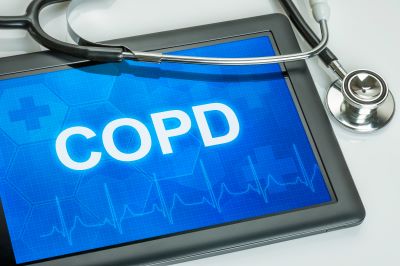 The difference between chronic bronchitis and COPD is that bronchitis is still curable. Once the bronchial tubes are permanently inflamed, the airways are chronically narrowed, and if patients may be unable to switch off causes such as smoking, the damage to the lungs is soon irreparable. The patient’s condition deteriorates continuously. Life-threatening complications such as emphysema, cor pulmonale, respiratory failure and cardiovascular diseases may occur.
The difference between chronic bronchitis and COPD is that bronchitis is still curable. Once the bronchial tubes are permanently inflamed, the airways are chronically narrowed, and if patients may be unable to switch off causes such as smoking, the damage to the lungs is soon irreparable. The patient’s condition deteriorates continuously. Life-threatening complications such as emphysema, cor pulmonale, respiratory failure and cardiovascular diseases may occur.
Symptoms of COPD include:
– coughing
– expectoration
– shortness of breath (especially exhalation is obstructed)
– decrease in performance
– weight loss (decrease in muscle mass and bone density due to testosterone and growth hormone deficiencies)
– psychological problems
Who is affected by COPD?
It is estimated that in Germany eight to twelve percent of the population is affected by COPD, which is also commonly referred to as “smoker’s lung”. In fact, one of the main causes is smoking. However, other factors such as persistent exposure to fine dust at the workplace can also be causative. Female smokers are more likely to develop COPD than male smokers. Another, but very rare, cause of COPD is a congenital alpha-1 antitrypsin deficiency. Antitrypsin normally inactivates proteases that cause inflammatory processes in the airways. If it is missing, chronic inflammation can destroy the bronchial tubes in the long term.
What helps with COPD?
Depending on the stage of the disease, sufferers can take the following steps to relieve symptoms and slow its progression:
– Quitting smoking
– Immune training
– Lung exercise
– Respiratory training
– Long-term oxygen therapy
– Healthy diet
In very severe cases, doctors sometimes advise lung transplantation.
What is emphysema
In emphysema, the air sacs in the lungs are gradually and irreversibly destroyed by chronic inflammation. When the affected person gains breaths, both the alveoli and the small bronchial tubes collapse. This primarily obstructs exhalation and causes the lungs to become more and more inflated. 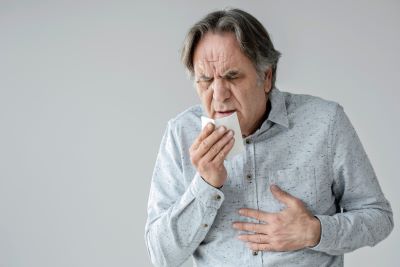 In addition to COPD, asthma can also be the cause of emphysema. In general, the disease is often preceded by heavy exposure to pollutants or tobacco use. Since prevention is so important here, risk factors must be eliminated as early as possible. Strengthening the immune system is also essential.
In addition to COPD, asthma can also be the cause of emphysema. In general, the disease is often preceded by heavy exposure to pollutants or tobacco use. Since prevention is so important here, risk factors must be eliminated as early as possible. Strengthening the immune system is also essential.
What can be done about emphysema?
In the case of emphysema, the same measures as for COPD are basically helpful. The aim of any treatment is to widen the narrowed airways and increase cystic fibrosis clearance. Affected patients should be informed in detail about their disease. By means of certain breathing techniques and targeted measures to cough up the mucus, additional relief can be achieved. Medicinal mushrooms also help to improve the quality of life in this respiratory disease.
Which natural remedies help with respiratory diseases?
Diseases of the respiratory tract usually cause annoying, sometimes even life-threatening symptoms. The causes of bronchitis, sinusitis, asthma and colds can be effectively combated with natural remedies. In the first instance, they alleviate the symptoms and help those affected to achieve a better quality of life. We would like to explain the role of various medicinal mushrooms in this context more detailed. First of all, here are a few tips on how to get your respiratory disease under control with simple home remedies.
Strengthen the immune system
In principle, a strong immune system is the prerequisite for not falling ill in the first place. However, if you do get sick, a strong immune system means a faster recovery. Your immune system benefits particularly from anything that stimulates blood circulation. This can be daily exercise in the fresh air in the form of walks, jogging, walking or hiking. Alternating baths and showers have a similar effect. Regular sauna sessions, steam baths, Kneipp treatments or the use of infrared cabins are both relaxing and beneficial to the circulation.
Another pillar of a strong immune system is a balanced, healthy diet. It should be rich in vital substances and above all contain sufficient quantities of vitamins C and D, which are important for the immune system. While vitamin C is found in relatively high doses in citrus fruits, some types of apples, peppers and cabbage, for example, vitamin D should be taken especially in the winter months, as our body cannot produce it sufficiently itself during this time. In addition to these vitamins, zinc is also essential for the proper functioning of the body’s defence mechanisms. Mucus-forming foods such as milk and individually known allergens, on the other hand, should be avoided.
Care for the kidneys and mucous membranes
The classic kidney tea is the natural remedy of choice for a cold. 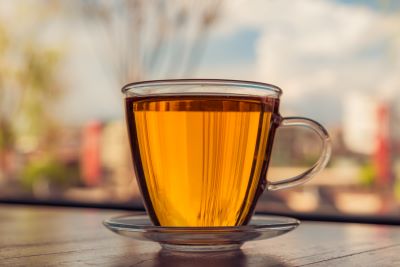 In general, it provides relief for all respiratory diseases related to cold and chill. According to TCM, it stimulates the flow of kidney energy and should ideally be drunk between 5 and 7 pm. By the way, grandmother’s chicken soup also has its uses for respiratory infections. It contains an extra portion of zinc for a well-functioning immune system. In addition, ingredients that stimulate the circulation or have antibiotic effects, such as chilli, garlic and ginger, provide faster relief from the symptoms. Also, do nasal rinses with physiological saline solution and avoid decongestant nose drops.
In general, it provides relief for all respiratory diseases related to cold and chill. According to TCM, it stimulates the flow of kidney energy and should ideally be drunk between 5 and 7 pm. By the way, grandmother’s chicken soup also has its uses for respiratory infections. It contains an extra portion of zinc for a well-functioning immune system. In addition, ingredients that stimulate the circulation or have antibiotic effects, such as chilli, garlic and ginger, provide faster relief from the symptoms. Also, do nasal rinses with physiological saline solution and avoid decongestant nose drops.
Which medicinal mushrooms help with respiratory illnesses?
Vital mushrooms have proven to be extremely helpful for various respiratory diseases. They alleviate infections and inflammations as well as allergic reactions. Some of them have a strengthening effect on the lungs. While they can be used alone as a natural remedy for mild illnesses such as a cold, they should only be taken as a supplement for severe illnesses. Important active ingredients in medicinal mushrooms such as Reishi and Cordyceps are, for example, triterpenes, beta-glucans and cordycepin. They can be taken both preventively and therapeutically.
The following properties of vital mushrooms help to cure respiratory diseases such as bronchitis naturally. They have the following effects:
– immune-modulating and -activating
– anti-inflammatory
– antiviral and antibacterial
– antioxidant
– detoxifying
– prebiotic
– mucosa-protecting (increased sIg A)
– relaxing
– positively regulating neurotransmitters and stress hormones
Cordyceps
According to TCM teachings, Cordyceps has a strong connection to the kidneys and lungs. 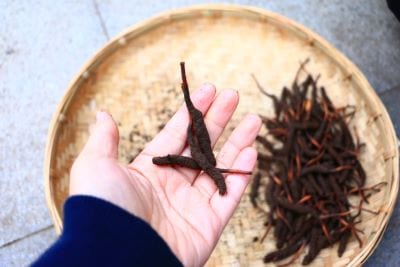 It strengthens them and thus relieves suffering that may occur due to a weakening of these organs. According to TCM, weak kidney energy is the cause of cold hands and feet, which in turn increase the body’s susceptibility to respiratory diseases and infections. Because of its strengthening effect on the lungs, Cordyceps is used by default for all lung diseases. It has also proven to be very valuable in relieving shortness of breath and exercise-induced asthma. It is also the natural remedy of choice in alternative medicine for bronchitis, rhinitis, sinusitis, tonsillitis and colds.
It strengthens them and thus relieves suffering that may occur due to a weakening of these organs. According to TCM, weak kidney energy is the cause of cold hands and feet, which in turn increase the body’s susceptibility to respiratory diseases and infections. Because of its strengthening effect on the lungs, Cordyceps is used by default for all lung diseases. It has also proven to be very valuable in relieving shortness of breath and exercise-induced asthma. It is also the natural remedy of choice in alternative medicine for bronchitis, rhinitis, sinusitis, tonsillitis and colds.
On a physiological level, the positive effect of Cordyceps can be attributed to various mechanisms. On the one hand it strengthens the immune system and on the other hand it has an anti-inflammatory and antioxidant effect. In addition, the Cordycepin contained in the Cordyceps vital mushroom acts like a natural antibiotic. It has been proven to inhibit the growth of bacteria of the strains Clostridium paraputrificum and Clostridium perfringens.
Reishi
Like Cordyceps, Reishi is also a time-honored TCM remedy for naturally curing respiratory conditions like bronchitis. Reishi contains organic germanium, which enables the red blood cells to transport more oxygen. Thus, despite respiratory disease, the body is relatively well supplied with the vital substance. Another central ingredient are the triterpenes. They counteract inflammation of the mucous membranes and also inhibit the release of histamine on contact with allergens. The latter is particularly helpful for allergy-related symptoms in the respiratory tract.
Because of its anti-allergic effect, the Reishi has proven itself many times in the treatment of allergic asthma. However, its intake also benefits people who are affected by non-allergic asthma. They benefit especially from its strengthening effect on the lungs and its anti-inflammatory properties. Inflammation causes oxidative stress. Medicinal mushrooms like Reishi have antioxidant effects especially because of the enzymes they contain. By lowering oxidative stress during an infection, the virulence of the pathogens can be significantly reduced and thus the infection can be overcome more quickly. In addition, the Reishi helps to “cleanse” the bronchial mucous membranes that are loaded with pollutants. It is a strongly detoxifying vital mushroom. The mucous membrane environment clearly benefits from this. Pathogens find it difficult to penetrate the strong mucosal barrier.
Reishi is also a tonic mushroom. It gives the organism new energy, which counteracts states of exhaustion in acute infections as well as chronic respiratory diseases. According to TCM teachings, the Reishi also expels heat and phlegm from the body. It thus takes on the function of an expectorant to some extent, making it easier to expectorate.
Auricularia
The Auricularia has a moisturizing effect on the mucous membranes. This predestines this mushroom for use in coughs with bloody sputum as well as bleeding from the nose and gums caused by dry mucous membranes.
Hericium
Hericium is a proven natural remedy when it comes to fighting allergies. 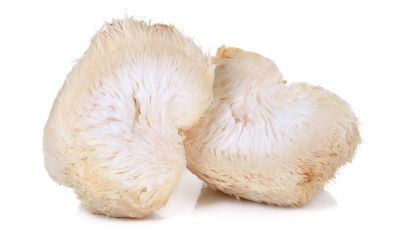 Its effect starts in the intestine: it supports the intestinal mucosa to regenerate quickly after an inflammation or ulceration. Its protective effect on the intestinal mucosa counteracts the development of leaky gut, which is often a cause of allergies. With regard to respiratory diseases, its main focus is on allergy-related complaints such as allergic rhinitis or allergic asthma.
Its effect starts in the intestine: it supports the intestinal mucosa to regenerate quickly after an inflammation or ulceration. Its protective effect on the intestinal mucosa counteracts the development of leaky gut, which is often a cause of allergies. With regard to respiratory diseases, its main focus is on allergy-related complaints such as allergic rhinitis or allergic asthma.
Coriolus
As early as the 13th century, Ming Dynasty healers in China used Coriolus to boost their patients’ immune systems. Today it is known that this effect is due to the glycoproteins PSK and PSP, which balance the immune system and thus ensure an effective immune defence. For this reason, Coriolus is excellent for the prophylaxis of viral infections and respiratory diseases during the cold season.
This fungus has both antiviral and antibacterial effects and is also antioxidant. This makes it predestined to protect the respiratory tract. According to TCM teachings, it is particularly effective in dissolving yellow-green mucus. As it also nourishes the liver and kidney yin, it is considered the remedy of choice for impaired lung function, exhaustion and chronic respiratory diseases.
Agaricus Blazei Murill (ABM)
In studies on mice, ABM scientists were able to clearly demonstrate that the medicinal mushroom Agaricus Blazei Murill is effective against bacteria of the strain Streptococcus pneumoniae. Mice infected with the bacteria while taking ABM preparations were significantly less likely to do so than after discontinuing the vital mushroom. Streptococcus pneumoniae is the central pathogen of pneumonia, sinusitis and otitis media. The antibacterial effect of ABM is primarily due to its beta-glucans. These activate the release of various interleukins and activate the complement cascade, thus supporting the work of the innate immune defence. In addition, ABM stimulates the natural killer cells, which makes the fight against viruses more efficient.
Shiitake
Shiitake is also one of the medicinal mushrooms that can raise the energy level of the body, the Qi. That is why it is a good support in the regeneration phase after an illness. 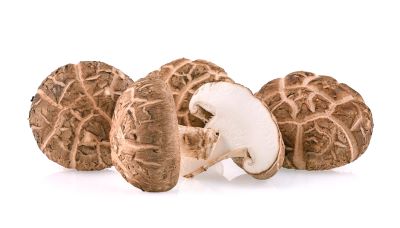 But its intake also reduces an existing susceptibility to colds, chronic coughs and allergies. Studies show that this fungus significantly raises secretory immunoglobulin A, which is so important for mucosal defence. In general, it alleviates states of exhaustion caused by illness. It also has a moisturizing effect on the mucous membranes of the lungs and intestines, which is beneficial for the loosening of mucus.
But its intake also reduces an existing susceptibility to colds, chronic coughs and allergies. Studies show that this fungus significantly raises secretory immunoglobulin A, which is so important for mucosal defence. In general, it alleviates states of exhaustion caused by illness. It also has a moisturizing effect on the mucous membranes of the lungs and intestines, which is beneficial for the loosening of mucus.
Poria Cocos
This vital mushroom primarily strengthens the spleen. According to TCM, it is the central organ for the general energy of the body and is closely related to the lungs. In addition, Poria Cocos expels moisture from the body, which in relation to respiratory diseases means above all a better expulsion of mucus.
Where can I get vital mushrooms against respiratory diseases?
Before you start looking for high-quality medicinal mushrooms, it is important to clarify which ones are indicated in your particular case. Depending on the complaints, concomitant diseases and individual constitution, a different mixture of vital mushrooms is suitable. Likewise, the dosage must be determined exactly. Therefore, first contact a specialist in TCM, a mycotherapist or use our free telephone consultation.
Pay attention to high quality standards!
Since mushrooms have the property of purifying their environment, they absorb all toxins from their surroundings. In you, the consumer, these unhealthy substances eventually accumulate in the body. To prevent this danger, you should only buy vital mushrooms from organic cultivation according to German guidelines. Only here you can be sure that pollutant-free substrates and no toxic pesticides are used.
In addition, the mushroom powder should be obtained from the whole mushroom. Only then all the valuable ingredients are contained. The same applies to the drying process: It must be carried out gently at below 40 ° Celsius, so that no valuable substances are destroyed. Finally, capsules are preferable to loose powder. In a capsule, the powder has a longer shelf life, is less susceptible to mould and is very easy to dose.






